Overview
The benefits of solar power are compelling. The fuel is free, abundant and inexhaustible. In fact, in just a year, six times as much usable solar energy hits the Earth as there is in total reserves from non-renewable sources. It is environmentally friendly, aids in the diversification of our fuel and energy supply, and is rapidly deployable.
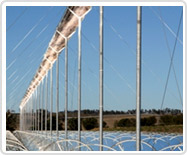
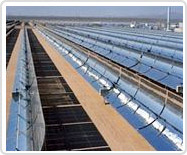
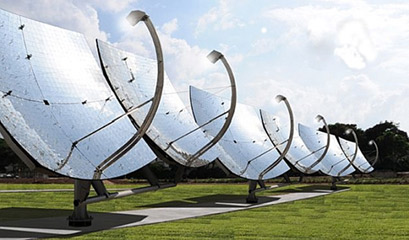
Technology for Generating Electricity
Thermal energy generated by using Concentrated Solar Power, generates a high temperature working fluid to drive either an organic rankine cycle power block that includes a turbine and generator or other thermally driven engines.
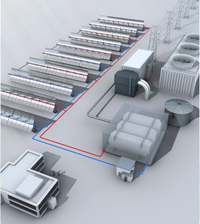
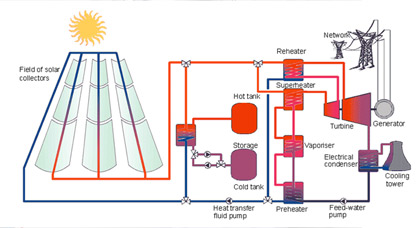
Advantages of Concentrated Parabolic Trough Technology Over Non-Renewable Fuels
The primary advantage of the Concentrated Solar Power parabolic trough over non renewable technologies is that it is environmentally responsible, as it uses an emission free fuel source. Non-renewable technologies, require a renewed fuel source which is diminishing at an alarming rate, and are anything but environmentally benign.
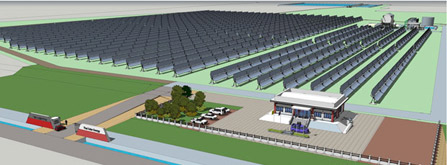
High-Temperature Collectors
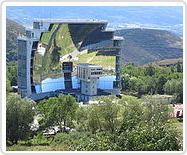

Concentrated Solar Power Plant Using Parabolic Trough Design
Where temperatures below 95°C are sufficient, as for space heating, flat-plate collectors of the non-concentrating type are generally used. The fluid-filled pipes can reach temperatures of 150 to 220 degrees Celsius when the fluid is not circulating. This temperature is too low for efficient conversion to electricity.
The efficiency of heat engines increases with the temperature of the heat source. To achieve this in solar thermal energy plants, solar radiation is concentrated by mirrors or lenses to obtain higher temperatures — a technique called Concentrated Solar Power (CSP). The practical effect of high efficiencies is to reduce the plant’s collector size and total land use per unit power generated, reducing the environmental impacts of a power plant as well as its expense.
As the temperature increases, different forms of conversion become practical. Up to 600°C, steam turbines, standard technology, have an efficiency up to 41%. Above this, gas turbines can be more efficient. Higher temperatures are problematic because different materials and techniques are needed. One proposal for very high temperatures is to use liquid fluoride salts operating between 700°C to 800°C, using multi-stage turbine systems to achieve 50% or more thermal efficiencies. The higher operating temperatures permit the plant to use higher-temperature dry heat exchangers for its thermal exhaust, reducing the plant’s water use — critical in the deserts where large solar plants are practical. High temperatures also make heat storage more efficient, because more watt-hours are stored per unit of fluid.
Since the CSP plant generates heat first of all, it can store the heat before conversion to electricity. With current technology, storage of heat is much cheaper and more efficient than storage of electricity. In this way, the CSP plant can produce electricity day and night. If the CSP site has predictable solar radiation, then the CSP plant becomes a reliable power plant. Reliability can further be improved by installing a back-up system that uses fossil energy. The back-up system can reuse most of the CSP plant, which decreases the cost of the back-up system.
With reliability, unused desert, no pollution (so long as gas turbines aren’t used) and no fuel costs, the obstacles for large deployment for CSP are cost, aesthetics, land use and similar factors for the necessary connecting high tension lines. Although only a small percentage of the desert is necessary to meet global electricity demand, still a large area must be covered with mirrors or lenses to obtain a significant amount of energy. An important way to decrease cost is the use of a simple design.
System designs
During the day the sun has different positions. If the mirrors or lenses do not move, then the focus of the mirrors or lenses changes. Therefore it seems unavoidable that there needs to be a tracking system that follows the position of the sun (for solar photovoltaics a solar tracker is only optional). The tracking system increases the cost and complexity. With this in mind, different designs can be distinguished in how they concentrate the light and track the position of the sun.
Parabolic trough designs
Sketch of a parabolic trough design. A change of position of the sun parallel to the receiver does not require adjustment of the mirrors.
Parabolic trough power plants use a curved, mirrored trough which reflects the direct solar radiation onto a glass tube containing a fluid (also called a receiver, absorber or collector) running the length of the trough, positioned at the focal point of the reflectors. The trough is parabolic along one axis and linear in the orthogonal axis. For change of the daily position of the sun perpendicular to the receiver, the trough tilts east to west so that the direct radiation remains focused on the receiver. However, seasonal changes in the in angle of sunlight parallel to the trough does not require adjustment of the mirrors, since the light is simply concentrated elsewhere on the receiver. Thus the trough design does not require tracking on a second axis.
The receiver may be enclosed in a glass vacuum chamber. The vacuum significantly reduces convective heat loss.
A fluid (also called heat transfer fluid) passes through the receiver and becomes very hot. Common fluids are synthetic oil, molten salt and pressurized steam. The fluid containing the heat is transported to a heat engine where about a third of the heat is converted to electricity.
Andasol 1 in Gaudix, Spain uses the Parabolic Trough design which consists of long parallel rows of modular solar collectors. Tracking the sun from East to West by rotation on one axis, the high precision reflector panels concentrate the solar radiation coming directly from the sun onto an absorber pipe located along the focal line of the collector. A heat transfer medium, a synthetic oil like in car engines, is circulated through the absorber pipes at temperatures up to 400°C and generates live steam to drive the steam turbine generator of a conventional power block.
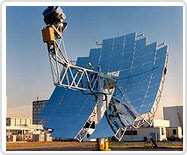
Concentrating solar power systems are a fast growing source of sustainable energy.
Full-scale parabolic trough systems consist of many such troughs laid out in parallel over a large area of land. Since 1985 a solar thermal system using this principle has been in full operation in California in the United States. It is called the SEGS system.[23] Other CSP designs lack this kind of long experience and therefore it can currently be said that the parabolic trough design is the most thoroughly proven CSP technology.
The Solar Energy Generating System (SEGS) is a collection of nine plants with a total capacity of 350MW. It is currently the largest operational solar system (both thermal and non-thermal). A newer plant is Nevada Solar One plant with a capacity of 64MW. Under construction are Andasol 1 and Andasol 2 in Spain with each site having a capacity of 50MW. Note however, that those plants have heat storage which requires a larger field of solar collectors relative to the size of the steam turbine-generator to store heat and send heat to the steam turbine at the same time. Heat storage enables better utilization of the steam turbine. With day and some nighttime operation of the steam-turbine Andasol 1 at 50MW peak capacity produces more energy than Nevada Solar One at 64 MW peak capacity, due to the former plant’s thermal energy storage system and larger solar field.
553MW new capacity is proposed in Mojave Solar Park, California. Furthermore, 59MW hybrid plant with heat storage is proposed near Barstow, California Near Kuraymat in Egypt, some 40MW steam is used as input for a gas powered plant. Finally, 25MW steam input for a gas power plant in Hassi R’mel, Algeria.
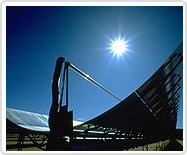
Power tower designs
Solar Two. Flat mirrors focus the light on the top of the tower. The white surfaces below the receiver are used for calibrating the mirror positions.
Power towers (also known as ‘central tower’ power plants or ‘heliostat’ power plants) capture and focus the sun’s thermal energy with thousands of tracking mirrors (called heliostats) in roughly a two square mile field. A tower resides in the center of the heliostat field. The heliostats focus concentrated sunlight on a receiver which sits on top of the tower. Within the receiver the concentrated sunlight heats molten salt to over 1000 degrees Fahrenheit. The heated molten salt then flows into a thermal storage tank where it is stored, maintaining 98% thermal efficiency, and eventually pumped to a steam generator. The steam drives a standard turbine to generate electricity. This process, also known as the “Rankine cycle” is similar to a standard coal-fired power plant, except it is fueled by clean and free solar energy.
The advantage of this design above the parabolic trough design is the higher temperature. Thermal energy at higher temperatures can be converted to electricity more efficiently and can be more cheaply stored for later use. Furthermore, there is less need to flatten the ground area. In principle a power tower can be built on a hillside. Mirrors can be flat and plumbing is concentrated in the tower. The disadvantage is that each mirror must have its own dual-axis control, while in the parabolic trough design one axis can be shared for a large array of mirrors.
SolarReserve, a Santa Monica, CA-based solar developer, utilizes this technology for the development of its concentrated solar thermal plants with storage. SolarReserve’s power tower technology has been developed by one of the world’s leading technology conglomerates, United Technologies Company (UTC). United Technologies’ subsidiary, Rocketdyne, demonstrated the technology at the Solar One and Solar Two power tower plants in Southern California. United Technologies has granted SolarReserve the proprietary technology know-how and an exclusive worldwide license to develop power plants using this proven technology.
In November of 2009, SolarReserve, and a Madrid-based renewable energy developer, Preneal, received the key environmental permit that is necessary for the construction of their 50 megawatt solar plant in Spain. This project will generate more than 300,000 megawatt hours of electricity per year, or enough electricity to power almost 70,000 homes in the region. The Alcazar Solar Thermal Power Project will deploy innovative molten salt, concentrated solar power tower technology, which is exclusively licensed to SolarReserve by United Technologies Corporation (UTC). Unlike other forms of renewable energy technology, the power tower with energy storage allows for continuous generation of electricity, on-demand, day or night.
In December of 2009, SolarReserve announced two power contracts in the United States. The first was with Pacific Gas and Electric (PG&E) for the sale of electricity from SolarReserve’s Solar Energy Project. The 150 megawatt solar energy project will be located 30 miles northwest of the city of Blythe in eastern Riverside County, California. When completed, SolarReserve’s facility will supply approximately 450,000 megawatt hours annually of clean, reliable electricity–enough to power up to 68,000 homes during peak electricity periods–utilizing its innovative energy storage capabilities. The second power contract was a 25-year power purchase agreement with NV Energy for the sale of electricity from SolarReserve’s Crescent Dunes Solar Energy Project. Developed and owned by SolarReserve’s subsidiary, Solar Energy, LLC, the project will be located near the town of Tonopah in Nye County, Nevada. When completed, Tonopah Solar Energy’s facility will supply approximately 480,000 megawatt hours annually.
In June 2008, eSolar, a Pasadena, CA-based company founded by Idealab CEO Bill Gross with funding from Google, announced a power purchase agreement (PPA) with the utility Southern California Edison to produce 245 megawatts of power. Additionally, in February 2009, eSolar announced it had licensed its technology to two development partners, the Princeton, N.J.-based NRG Energy, Inc., and the India-based ACME Group. In the deal with NRG, the companies announced plans to jointly build 500 megawatts of concentrating solar thermal plants throughout the United States. The target goal for the ACME Group was nearly double; ACME plans to start construction on its first eSolar power plant this year, and will build a total of 1 gigawatt over the next 10 years.
eSolar’s proprietary sun-tracking software coordinates the movement of 24,000 1 meter-square mirrors per 1 tower using optical sensors to adjust and calibrate the mirrors in real time. This allows for a high density of reflective material which enables the development of modular concentrating solar thermal (CSP) power plants in 46 megawatt (MW) units on approximately π square mile parcels of land, resulting in a land-to-power ratio of 4 acres per 1 megawatt.
BrightSource Energy entered into a series of power purchase agreements with Pacific Gas and Electric Company in March 2008 for up to 900MW of electricity, the largest solar power commitment ever made by a utility. BrightSource is currently developing a number of solar power plants in Southern California, with construction of the first plant planned to start in 2009.
In June 2008, BrightSource Energy dedicated its 4-6 MW Solar Energy Development Center (SEDC) in Israel’s Negev Desert. The site, located in the Rotem Industrial Park, features more than 1,600 heliostats that track the sun and reflect light onto a 60 meter-high tower. The concentrated energy is then used to heat a boiler atop the tower to 550 degrees Celsius, generating superheated steam.
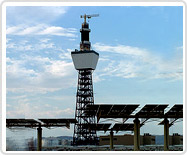
A working tower power plant is PS10 in Spain with a capacity of 11MW.
The 15MW Solar Tres plant with heat storage is under construction in Spain. In South Africa, a 100MW solar power plant is planned with 4000 to 5000 heliostat mirrors, each having an area of 140 m². A 10MW power plant in Cloncurry, Australia (with purified graphite as heat storage located on the tower directly by the receiver).
Out of commission are the 10MW Solar One (later redeveloped and made into Solar Two) and the 2MW Themis plants.
A cost/performance comparison between power tower and parabolic trough concentrators was made by the NREL which estimated that by 2020 electricity could be produced from power towers for 5.47 ₡/kWh and for 6.21 ₡/kWh from parabolic troughs. The capacity factor for power towers was estimated to be 72.9% and 56.2% for parabolic troughs. There is some hope that the development of cheap, durable, mass producible heliostat power plant components could bring this cost down.
Dish designs
A parabolic solar dish concentrating the sun’s rays on the heating element of a Stirling engine. The entire unit acts as a solar tracker.
A dish system uses a large, reflective, parabolic dish (similar in shape to satellite television dish). It focuses all the sunlight that strikes the dish up onto to a single point above the dish, where a receiver captures the heat and transforms it into a useful form. Typically the dish is coupled with a Stirling engine in a Dish-Stirling System, but also sometimes a steam engine is used. These create rotational kinetic energy that can be converted to electricity using an electric generator.
The advantage of a dish system is that it can achieve much higher temperatures due to the higher concentration of light (as in tower designs). Higher temperatures leads to better conversion to electricity and the dish system is very efficient on this point. However, there are also some disadvantages. Heat to electricity conversion requires moving parts and that results in maintenance. In general, a centralized approach for this conversion is better than the dencentralized concept in the dish design. Second, the (heavy) engine is part of the moving structure, which requires a rigid frame and strong tracking system. Furthermore, parabolic mirrors are used instead of flat mirrors and tracking must be dual-axis.
In 2005 Southern California Edison announced an agreement to purchase solar powered Stirling engines from Stirling Energy Systems over a twenty year period and in quantities (20,000 units) sufficient to generate 500 megawatts of electricity. Stirling Energy Systems announced another agreement with San Diego Gas & Electric to provide between 300 and 900 megawatts of electricity. However, as of October 2007 it was unclear whether any progress had been made toward the construction of the 1 MW test plant, which was supposed to come online some time in 2007.
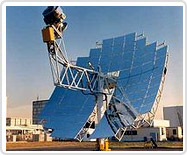
Fresnel reflectors
Wind load is avoided by the low position of the mirrors. Light construction of tracking system due to separation from the receiver.
A linear Fresnel reflector power plant uses a series of long, narrow, shallow-curvature (or even flat) mirrors to focus light onto one or more linear receivers positioned above the mirrors. On top of the receiver a small parabolic mirror can be attached for further focusing the light. These systems aim to offer lower overall costs by sharing a receiver between several mirrors (as compared with trough and dish concepts), while still using the simple line-focus geometry with one axis for tracking. This is similar to the trough design (and different from central towers and dishes with dual-axis). The receiver is stationary and so fluid couplings are not required (as in troughs and dishes). The mirrors also do not need to support the receiver, so they are structurally simpler. When suitable aiming strategies are used (mirrors aimed at different receivers at different times of day), this can allow a denser packing of mirrors on available land area.
Recent prototypes of these types of systems have been built in Australia (CLFR) and by Solarmundo in Belgium. The Solarmundo research and development project, with its pilot plant at Liège, was closed down after successful proof of concept of the Linear Fresnel technology. Subsequently, Solar Power Group GmbH (SPG), based in Munich, Germany, was founded by some Solarmundo team members. A Fresnel-based prototype with direct steam generation was built by SPG in conjunction with the German Aerospace Center (DLR).
Based on the Australian prototype, a 177MW plant had been proposed near San Luis Obispo in California and would be built by Ausra. But Ausra sold its planned California solar farm to First Solar. First Solar will not build the Carrizo project, and the deal has resulted in the cancellation of Ausra’s contract to provide 177 megawatts to P.G.& E. Small capacity plants are an enormous economical challenge with conventional parabolic trough and drive design – few companies build such small projects. There are plans for SHP Europe, former Ausra subsidiary, to build a 6.5 MW combined cycle plant in Portugal. The German company SK Energy]) has plans to build several small 1-3 MW plants in Southern Europe (esp. in Spain) using Fresnel mirror and steam drive technology (Press Release).
In May 2008, the German Solar Power Group GmbH and the Spanish Laer S.L. agreed the joint execution of a solar thermal power plant in central Spain. This will be the first commercial solar thermal power plant in Spain based on the Fresnel collector technology of the Solar Power Group. The planned size of the power plant will be 10 MW a solar thermal collector field with a fossil co-firing unit as backup system. The start of constructions is planned for 2009. The project is located in Gotarrendura, a small renewable energy pioneering village, about 100 km northwest of Madrid, Spain.
A Multi-Tower Solar Array (MTSA) concept, that uses a point-focus Fresnel reflector idea, has also been developed, but has not yet been prototyped.
Since March 2009, the Fresnel solar power plant PE 1 of the German company Novatec Biosol is in commercial operation in southern Spain . The solar thermal power plant is based on linear Fresnel collector technology and has an electrical capacity of 1.4 MW.
Beside a conventional power block, PE 1 comprises a solar boiler with mirror surface of around 18,000m². The steam is generated by concentrating direct solar irradiation onto a linear receiver which is 7.40m above the ground. An absorber tube is positioned in the focal line of the mirror field in which water is evaporated directly into saturated steam at 270°C and at a pressure of 55 bar by the concentrated solar energy.
Fresnel solar power plant PE 1 in southern Spain
Linear Fresnel Reflector (LFR) and compact-LFR Technologies
Rival single axis tracking technologies include the relatively new Linear Fresnel reflector (LFR) and compact-LFR (CLFR) technologies. The LFR differs from that of the parabolic trough in that the absorber is fixed in space above the mirror field. Also, the reflector is composed of many low row segments, which focus collectively on an elevated long tower receiver running parallel to the reflector rotational axis.
This system offers a lower cost solution as the absorber row is shared among several rows of mirrors. However, one fundamental difficulty with the LFR technology is the avoidance of shading of incoming solar radiation and blocking of reflected solar radiation by adjacent reflectors. Blocking and shading can be reduced by using absorber towers elevated higher or by increasing the absorber size, which allows increased spacing between reflectors remote from the absorber. Both these solutions increase costs, as larger ground usage is required.
The compact linear Fresnel reflector (CLFR) offers an alternate solution to the LFR problem. The classic LFR has only one linear absorber on a single linear tower. This prohibits any option of the direction of orientation of a given reflector. Since this technology would be introduced in a large field, one can assume that there will be many linear absorbers in the system. Therefore, if the linear absorbers are close enough, individual reflectors will have the option of directing reflected solar radiation to at least two absorbers. This additional factor gives potential for more densely packed arrays, since patterns of alternative reflector inclination can be set up such that closely packed reflectors can be positioned without shading and blocking.
CLFR power plants offer reduced costs in all elements of the solar array. These reduced costs encourage the advancement of this technology. Features that enhance the cost effectiveness of this system compared to that of the parabolic trough technology include minimized structural costs, minimized parasitic pumping losses, and low maintenance. Minimized structural costs are attributed to the use of flat or elastically curved glass reflectors instead of costly sagged glass reflectors are mounted close to the ground. Also, the heat transfer loop is separated from the reflector field, avoiding the cost of flexible high pressure lines required in trough systems. Minimized parasitic pumping losses are due to the use of water for the heat transfer fluid with passive direct boiling. The use of glass-evacuated tubes ensures low radiative losses and is inexpensive. Studies of existing CLFR plants have been shown to deliver tracked beam to electricity efficiency of 19% on an annual basis as a preheater.

Fresnel lenses
Prototypes of Fresnel lens concentrators have been produced for the collection of thermal energy by International Automated Systems. No full-scale thermal systems using Fresnel lenses are known to be in operation, although products incorporating Fresnel lenses in conjunction with photovoltaic cells are already available.
The advantage of this design is that lenses are cheaper than mirrors. Furthermore, if a material is chosen that has some flexibility, then a less rigid frame is required to withstand wind load.
MicroCSP
“MicroCSP references solar thermal technologies in which concentrating solar power (CSP) collectors are based on the designs used in traditional Concentrating Solar Power systems found in the Mojave Desert but are smaller in collector size, lighter and operate at lower thermal temperatures usually below 600 degrees F. These systems are designed for modular field or rooftop installation where they are easy to protect from high winds, snow and humid deployments.
Heat exchange
Heat in a solar thermal system is guided by five basic principles: heat gain; heat transfer; heat storage; heat transport; and heat insulation. Here, heat is the measure of the amount of thermal energy an object contains and is determined by the temperature, mass and specific heat of the object.
Heat gain is the heat accumulated from the sun in the system. Solar thermal heat is trapped using the greenhouse effect; the greenhouse effect in this case is the ability of a reflective surface to transmit short wave radiation and reflect long wave radiation. Heat and infrared radiation (IR) are produced when short wave radiation light hits the absorber plate, which is then trapped inside the collector. Fluid, usually water, in the absorber tubes collect the trapped heat and transfer it to a heat storage vault.
Heat is transferred either by conduction or convection. When water is heated, kinetic energy is transferred by conduction to water molecules throughout the medium. These molecules spread their thermal energy by conduction and occupy more space than the cold slow moving molecules above them. The distribution of energy from the rising hot water to the sinking cold water contributes to the convection process. Heat is transferred from the absorber plates of the collector in the fluid by conduction. The collector fluid is circulated through the carrier pipes to the heat transfer vault. Inside the vault, heat is transferred throughout the medium through convection.
Heat storage enables solar thermal plants to produce electricity during hours without sunlight. Heat is transferred to a thermal storage medium in an insulated reservoir during hours with sunlight, and is withdrawn for power generation during hours lacking sunlight. Thermal storage mediums will be discussed in a heat storage section. Rate of heat transfer is related to the conductive and convection medium as well as the temperature differences. Bodies with large temperature differences transfer heat faster than bodies with lower temperature differences.
Heat transport refers to the activity in which heat from a solar collector is transported to the heat storage vault. Heat insulation is vital in both heat transport tubing as well as the storage vault. It prevents heat loss, which in turn relates to energy loss, or decrease in the efficiency of the system.
Heat storage
Heat storage allows a solar thermal plant to produce electricity at night and on overcast days. This allows the use of solar power for base load generation as well as peak power generation, with the potential of displacing both coal and natural gas fired power plants. Additionally, the utilization of the generator is higher which reduces cost.
Heat is transferred to a thermal storage medium in an insulated reservoir during the day, and withdrawn for power generation at night. Thermal storage media include pressurized steam, concrete, a variety of phase change materials, and molten salts such as sodium and potassium nitrate.
Steam accumulator
The PS10 solar power tower stores heat in tanks as pressurized steam at 50 bar and 285°C. The steam condenses and flashes back to steam, when pressure is lowered. Storage is for one hour. It is suggested that longer storage is possible, but that has not been proven yet in an existing power plant.
Molten salt storage
A variety of fluids have been tested to transport the sun’s heat, including water, air, oil, and sodium, but molten salt was selected as best. Molten salt is used in solar power tower systems because it is liquid at atmosphere pressure, it provides an efficient, low-cost medium in which to store thermal energy, its operating temperatures are compatible with today’s high-pressure and high-temperature steam turbines, and it is non-flammable and nontoxic. In addition, molten salt is used in the chemical and metals industries as a heat-transport fluid, so experience with molten-salt systems exists in non-solar settings.
The molten salt is a mixture of 60 percent sodium nitrate and 40 percent potassium nitrate, commonly called saltpeter. The salt melts at 430 °F (220 °C) and is kept liquid at 550 °F (290 °C) in an insulated storage tank. The uniqueness of this solar system is in de-coupling the collection of solar energy from producing power, electricity can be generated in periods of inclement weather or even at night using the stored thermal energy in the hot salt tank. Normally tanks are well insulated and can store energy for up to a week. As an example of their size, tanks that provide enough thermal storage to power a 100-megawatt turbine for four hours would be about 30 feet tall and 80 feet in diameter.
The Solar Tres power plant in Spain is expected to be the first commercial solar thermal power plant to utilize molten salt for heat storage and nighttime generation.
Graphite heat storage
Direct
The proposed power plant in Cloncurry Australia will store heat in purified graphite. The plant has a power tower design. The graphite is located on top of the tower. Heat from the heliostats goes directly to the storage. Heat for energy production is drawn from the graphite. This simplifies the design.
Indirect
Molten salts coolants are used to transfer heat from the reflectors to heat storage vaults. The heat from the salts are transferred to a secondary heat transfer fluid via a heat exchanger and then to the storage media, or alternatively, the salts can be used to directly heat graphite. Graphite is used as it has relatively low costs and compatibility with liquid fluoride salts. The high mass and volumetric heat capacity of graphite provide an efficient storage medium.
Phase-change materials for storage
Phase Change Material (PCMs) offer an alternate solution in energy storage. Using a similar heat transfer infrastructure, PCMs have the potential of providing a more efficient means of storage. PCMs can be either organic or inorganic materials. Advantages of organic PCMs include no corrosives, low or no undercooling, and chemical and thermal stability. Disadvantages include low phase-change enthalpy, low thermal conductivity, and inflammability. Inorganics are advantageous with greater phase-change enthalpy, but exhibit disadvantages with undercooling, corrosion, phase separation, and lack of thermal stability. The greater phase-change enthalpy in inorganic PCMs make hydrates salts a strong candidate in the solar energy storage field.
Use of water
A design which requires water for condensation or cooling may conflict with location of solar thermal plants in desert areas with good solar radiation but limited water resources. The conflict is illustrated by plans of Solar Millennium, a German company, to build a plant in the Amargosa Valley of Nevada which would require 20% of the water available in the area. Some other projected plants by the same and other companies in the Mojave Desert of California may also be affected by difficulty in obtaining adequate and appropriate water rights. California water law currently prohibits use of potable water for cooling.
Other designs require less water. The proposed Ivanpah Solar Power Facility in south-eastern California will conserve scarce desert water by using air-cooling to convert the steam back into water. Compared to conventional wet-cooling, this results in a 90 percent reduction in water usage . The water is then returned to the boiler in a closed process which is environmentally-friendly.

